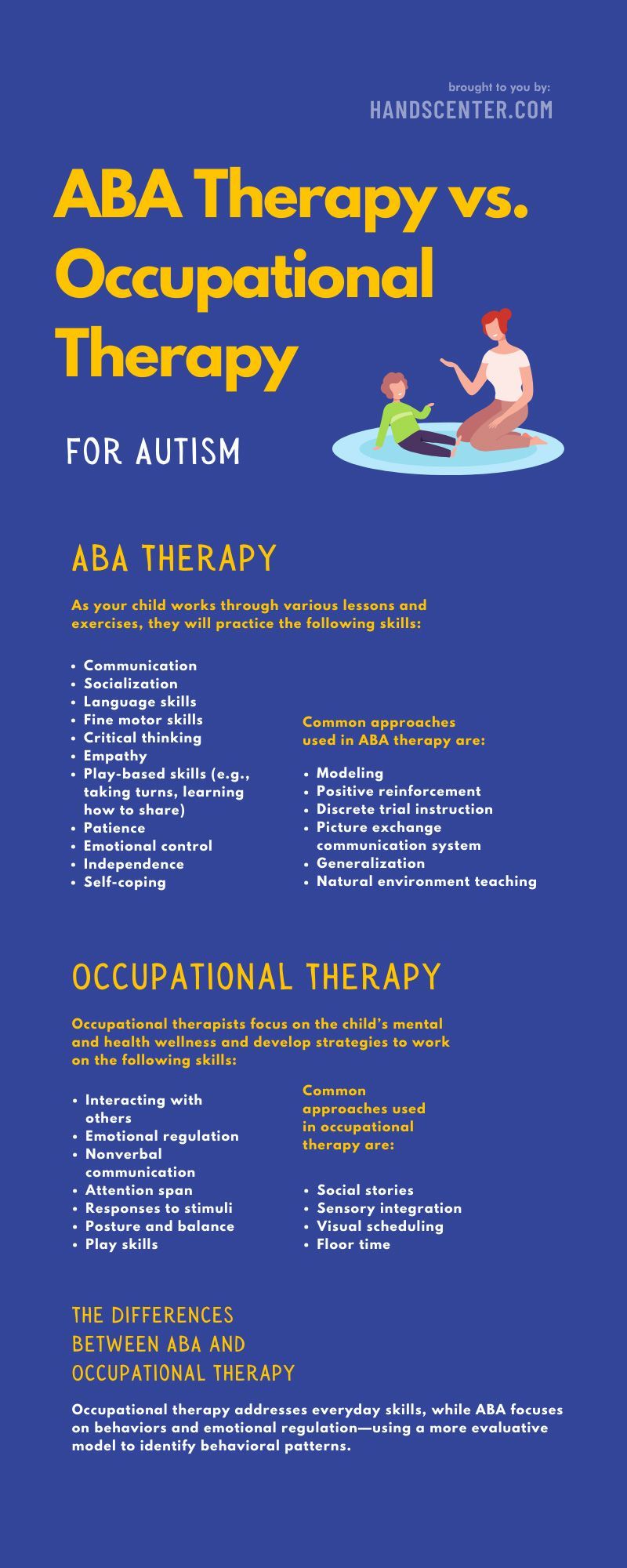ABA Therapy vs. Occupational Therapy for Autism
When you received your child’s diagnosis, you were probably recommended to research the many therapies and support groups to aid their developmental journey. While it may initially seem overwhelming, you must understand the goals and purposes of each treatment and approach. That way, you can get professional advice and instruction on supporting your child outside of a therapy or academic setting.
Two of the most common therapies in autism treatment are ABA and occupational therapy. While they have similar goals, they differ in approach and strategy. It’s also important to note that each technique is individualized for your child. What may work for one child may not work for the next. This is why therapists work diligently to ensure your child gets an individualized report and lesson plan to set goals and work on their areas of opportunity.
Our team at HANDS encourages our parents and caregivers to be involved in therapy. That’s why we’re always ready to educate our readers on the various approaches and strategies used in autism therapy centers. Keep reading to better understand ABA and occupational therapy for autism and the differences between the two.
ABA Therapy
One of the most popular approaches in autism treatment and other developmental disorders is applied behavior analysis, or ABA therapy. This method focuses on teaching and developing specific behaviors based on personalized evaluation. ABA therapy can be conducted in both a center-based setting as well as the home and is typically practiced for up to 40 hours a week.
This playful therapy breaks down larger goals into small steps to help the child understand more easily. Goals are determined by the child’s developmental milestones and will change and progress in the course of therapy. A play-based approach allows children to learn naturally and feel more comfortable sharing their feelings. Therapists can address behaviors and create individualized goals through playing and communication practices.
As your child works through various lessons and exercises, they will practice the following skills:
- Communication
- Socialization
- Language skills
- Fine motor skills
- Critical thinking
- Empathy
- Play-based skills (e.g., taking turns, learning how to share)
- Patience
- Emotional control
- Independence
- Self-coping
In addition to the many skills they learn, ABA therapists use various techniques to boost positive behaviors and minimize challenging ones. The approach they use will vary based on their target behaviors, individual assessment, and the environment they’re in.
Common approaches used in ABA therapy are:
- Modeling
- Positive reinforcement
- Discrete trial instruction
- Picture exchange communication system
- Generalization
- Natural environment teaching
Occupational Therapy
Another approach therapists use for autism treatment is occupational therapy. OT is a great approach for learners to develop and maintain their ability to engage in daily activities. Children will learn various ways to gain independence and fulfilling skills. OT can also help with Executive Functioning Skills (EF). EF skills are skills that help all of us in every aspect of our daily lives. Planning, organizing, time management, working memory, flexible thinking, impulse control and staying safe are examples of executive functioning skills. Occupational therapists work hard to help children better their handwriting, perfect their fine motor skills, and target their sensory processing differences.
This approach will help children remove barriers hindering their learning skills and help them self-soothe or cope in new or stress-inducing environments. Occupational therapists focus on the child’s mental and health wellness and develop strategies to work on the following skills:
- Interacting with others
- Emotional regulation
- Nonverbal communication
- Attention span
- Responses to stimuli
- Posture and balance
- Play skills
Common approaches used in occupational therapy are:
- Social stories
- Sensory integration
- Visual scheduling
- Floor time
The Differences Between ABA and Occupational Therapy
ABA and occupational therapy are two common approaches that support millions of children with autism and help them reach developmental milestones. However, where do these therapies differ, and which is better for your child? The main difference between ABA and occupational therapy is the time demand.
While every child is different, ABA therapy requires more time than occupational therapy. While ABA takes about 10 to 40 hours a week, OT typically requires 30 minutes to one hour weekly. In most cases, you will find that occupational therapy also focuses more on how parents and caregivers can support their children in various environments.
Another difference between ABA and occupational therapy is their goals. Occupational therapy addresses everyday skills, while ABA focuses on behaviors and emotional regulation—using a more evaluative model to identify behavioral patterns.
How They Work Together
Although they differ, both approaches can be used in tandem to improve meaningful behavior and life skills. From enhancing quality of life to bettering the relationship between your child and other family members, these therapy approaches allow the child to feel understood and confident in learning.
OT and ABA therapists will communicate to develop a therapy plan tailored to your child’s strengths and areas of opportunity. This will improve your child’s chances of success—allowing them to become more comfortable in their unique way of learning.
Sometimes, the behavior therapist will sit in on the other sessions to monitor the child’s improvements and develop at-home plans for caregivers and parents. That’s why many autism centers stress guardians' involvement in therapy sessions. Children will be given many opportunities to work through and make positive changes with professional guidance and support, which will turn into second-nature behavior. Your child can use their learned skills in other environments, not just in a center-based setting.
Work With Compassionate Professionals
The best way to ensure your child gets the care they need is by working with compassionate professionals. Finding the right therapy for your child is essential to their future care and support. At HANDS Center, we strive for our learners to reach beyond their goals and conquer the odds stacked against them.
It’s our mission to deliver the best care and support with our treatment and resources. We built our clinic to be a fun and relaxing space for children to soar! We have flexible treatment spaces and classrooms to ensure your child gets the accommodation they need and ideal support. With our knowledgeable team, we can work together to build a solid developmental growth foundation for your child.
We would love to help you and your child in any way we can. Located in North Carolina, we offer autism therapy services and parent support courses to educate families on the best approaches for their children. For more information, contact our team today, and we can assist you.







